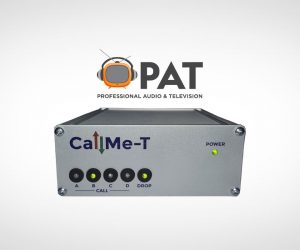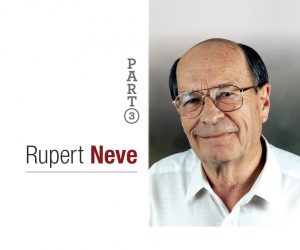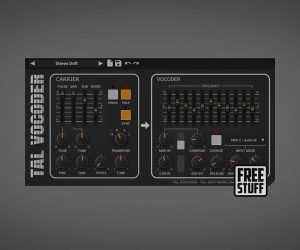
Interview with John Meyer, Part 1
John and Helen Meyer just celebrated 50 years of love that began when the young inventor showed Helen what Sgt. Pepper’s sounded like on a great set of speakers. The two have been introducing the rest of the world to great speakers ever since. Recently, Meyer Sound’s top tier descended on Sydney to celebrate its new alliance with Audio Brands. We sat down with the Meyers to talk about 12-year olds on radio, the Grateful Dead’s Wall of Sound and chasing audio holograms. Here is the first instalment.
I grew up in an FM radio station in Berkeley called KPFA. I first started going there when I was seven. It was an educational station, and they’d do live theatrical broadcasts of Tom Sawyer and Huckleberry Finn. I could memorise the lines, so I got some bit parts.
At 11, I got my own program telling fairy tales. I had speech coaches teach me how to tell a story on radio, create emotion and suspense.
I’d do one for 15 minutes and use the spare 15 minutes to interview kids around the station. Kids of famous people in Berkeley like (musician) Larry Livermore and (film critic) Pauline Kael. Sometimes they wouldn’t show up, so I wanted to have a second fairy tale in the can.
I learned how to remote control the tape recorder in the control room. I’d come half an hour earlier and record another 15-minute segment in case there was a no-show.
I started getting more interested in learning the technology. When I was 12 I wanted to run the records for the classical show. It was very strict, and you had to have your third class licence to do that.
The transmitter was expensive and remote-controlled, so you had to learn the 10 steps to turn it on and off, otherwise you could blow it up. You also had to make sure it was set up so you were monitoring the real broadcast coming back.
I became interested in the transmitter room up on the hill, but you had to have a Second Class license to go inside. There were some 17-year-olds in there, and I decided I wanted to be part of that; be more than just a disc jockey.
That was hard. I spent a whole summer learning all the requirements. You had to be able to draw an FM radio with a heterodyne, name all the parts and describe what they did. And questions like, if you’re charging a lead-acid battery or discharging the battery, when does it give off hydrogen gas? I just memorised the whole SEC book. I figured if I knew how everything worked, I’d be able to pass the test.
I passed the test, which was considered a real milestone. It was really exciting that I was part of the group of people that had permission to go in.
Those 50,000W transmitters are really powerful. They would vaporise little animals touching it, just disappear in a cloud of dust. But I hardly even wanted to go look at it, I just wasn’t that interested. The fact you could take a signal like a record, send it all over California and recover it with less distortion than a record was what fascinated me.
AM was already established. The whole idea was FM would do high quality classical music, and AM would do sports and announcing. Then Governments all around the world put it in, and it spread. To think about the Government getting involved today and making something better… it was exciting to be part of that.
Live broadcasts were our thing. We even experimented with early stereo broadcasts. We had condenser microphones which cost the same as a car at that time, and we were using stereo to create that environment of being at a live show.
I don’t know if that was ever completely accomplished, but that was the whole idea. What have we lost with the record compared to the live show? It got me more interested in learning about how we could measure that or build better speakers. That became my passion, to see if we could build things to make that experience more direct.
The movie industry did a lot of work on getting the sound better. People complained in the early days of movies that vibrato was ruined and the pianos didn’t sound as good.
Walt Disney spent a fortune trying to get Fantasia to sound good. Things like oscillators with Hewlett-Packard to make a panning sound, building and installing the Fantasound multi-channel speaker system to re-create the sound of a live orchestra. They had a 100-page magazine article on the work they did.
It didn’t make any money for the time, but it was a milestone. Those early days gave me an idea of why I wanted to continue on that path.
When we first started working on Constellation to make concert halls, we did experiments in Switzerland. This was in the ’70s, we miked all the instruments and then transmitted it out with a combination of speakers on the stage and more speakers to broadcast it.
We realised right away that a close-miked violin doesn’t sound like a violin. Moving around close to a violin yields lots of variation, while moving 20-30 feet away creates a more homogeneous feel. All the instruments were really different in the near-field.
After a year-and-a-half in Switzerland we realised we’d have to re-think it and make it more realistic. That led to what we liked about the idea of Constellation. Instead of picking up the direct sound and trying to re-broadcast it, what you do is pick up everything and recreate early reflections; let the direct sound come, directly.
Then we could kill the room sound and use high-powered computers to create a cathedral or concert hall. We studied 50 concert halls around the world. We went and measured them very carefully, not just from the stage. We wanted to know what it was like in the balcony, under the balcony, so we’d have a real map of the place. It would take us a week to measure a concert hall so players would recognise the reproduction.
It’s a perfect fit for Dolby’s Atmos. They’ve created the solution of objects and we’re going to create change in the room. If they want a helicopter back there, they put a speaker back there to create the sound. We’re about creating the space; going from a submarine that’s reverberant and awful, but when you stick your head out, it’s just like you’re outside.
















RESPONSES